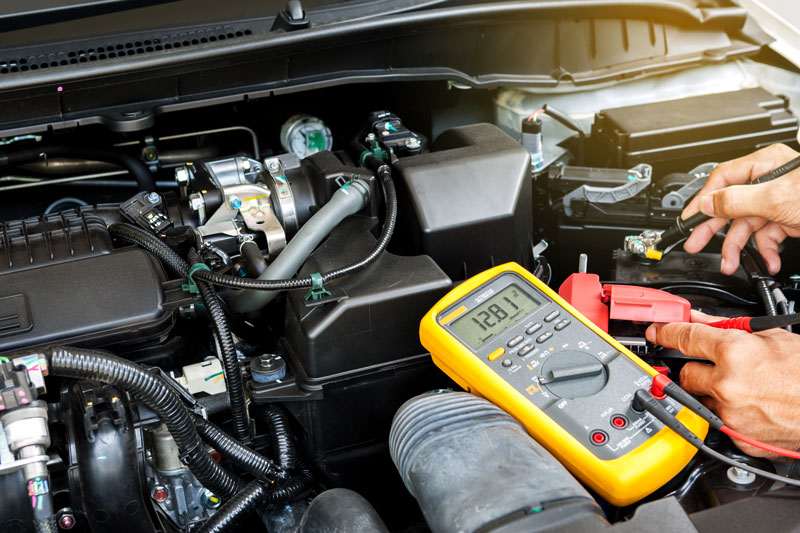By Kevin Roberts
Last time we showed how we can infer Available Voltage from amperage in a circuit. Doing so offers us a second path to test harness integrity.
Today let’s consider the series circuit in which the intended loads are not balanced. In a past life, I trained for a company that had on its curriculum staff the originator of this idea. For the moment I will skip the introduction to his question, but he asked what would happen if we connected a low wattage bulb in series with a high wattage bulb. If you’re like me at the time, you are asking “What difference does it make?” But as I subsequently discovered, not only is it a good test for your basic understanding of electrical principles, it actually describes a common component in most vehicles built throughout the 20th century; one you may be unaware of.
First the two bulbs. If you take an incandescent headlight bulb and a 194 clearance lamp bulb and connect them in series, what happens?
See Figure 1 below. (For simplicity I show a single filament headlight bulb.)
Figure 1

To start with we may reasonably ask the question, “Which is the highest resistance?” Hold that thought.
The key to answering what is happening in Figure 1 is to remember all the words that mean the same thing. In the first article in this series, we learned that every electrical device “is a Load, that functions as a Current Limiter, because it has Resistance and that can be measured using Voltage Drop Testing with a meter.”
So, each bulb in Figure 1 is:
A Load.
A Resistance.
A Voltage Drop.
A Current Limiter.
Then we need to add to that Kirchhoff’s Amperage Law. Amperage going into a connection is the same as amperage going out of a connection. Therefore, the amperage flow is consistent everywhere in the circuit.
If you remember the idea of Available Voltage, you may understand that since in Figure 1 we have two different resistances, we also have two different Voltage Drops. Combine this with consistent amperage and you get what may be a nonintuitive result. If I phrase it thusly, “You flow the same amperage through the headlight bulb as you do through the clearance light bulb,” that may be quite intuitive. But only if you have trained your brain to avoid a commonly held misconception. The misconception is that a large load has a high resistance. In reality, a large load is a small resistance. A small load is a large resistance.
Many Technicians misconstrue a high resistance with a large load.
These are some of the answers I get in class to the question “What is happening in this circuit?”
- “The bulbs will glow equally.”
- “The headlight bulb will draw higher amperage.”
- “The 194 bulb will blow like a fuse.”
But by applying the two principles, that of Available Voltage with Kirchhoff’s Amperage Law, the answer becomes clear.
The Voltage Drop of each load varies with resistance, so each load has a different Available Voltage.
The higher the Resistance, in this case the 194 bulb, the higher the Voltage Drop, which is equal to a higher Available Voltage. Likewise, the lower Resistance headlight bulb has a lower Voltage Drop which is equal to a lower Available Voltage.
See Figure 2 below.
Figure 2

Equal current through different resistances, in this case incandescent bulbs, will vary the brightness of the bulb.
Each load serves as a current limiter for the other load.
So, what would you expect to be the Available Voltage to each load?
The answer may surprise you.
See Figure 3 below.
Figure 3

This usually surprises the students.
The 194 “is a Load, that functions as a Current Limiter, because it has Resistance and that can be measured using Voltage Drop Testing with a meter.”
But the headlamp bulb also “is a Load, that functions as a Current Limiter, because it has Resistance and that can be measured using Voltage Drop Testing with a meter.”
The resistance of the 194 is so much higher than the headlamp bulb that the following occurs.
The 194 bulb draws somewhere around .25 amps through a proper harness.
The headlamp would draw around 4.5 amps through a proper harness, but the current limiting function of the 194 only allows .25 amps through.
An amperage of .25 amps in a headlight bulb won’t even get the bulb warm, much less cause it to glow.
The resistance of the headlight bulb is so low that it essentially functions as a wire.
Does that make sense?
Let’s find out.
What happens if I disconnect the positive battery feed (assuming there is a single point to do so) and place a 194 bulb with a pigtail between the battery post and the battery cable terminal that I just removed, and then crank the engine?
Oops, out of space, we’ll need to answer that next time.






